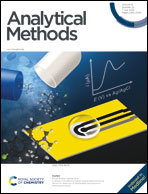A simple cost-effective paper-based electrochemical device for detection of adulterated sibutramine in slimming products†
Abstract
This work presents the first paper-based electrochemical device, or ePAD, for direct detection of adulterated sibutramine in slimming products. The ePAD was fabricated using a screen-printing technique for defining the hydrophilic area for sample loading and for the working, reference and counter electrodes. The ePAD gave reproducible responses comparable to both conventional rod electrodes and commercial screen-printed electrodes (SPEs). Use of paper to fabricate the ePAD device provides advantages over the conventional SPE platforms (e.g. glass, ceramics and polymers) in terms of biocompatibility, strong capillary action and environmental friendliness. To detect sibutramine, square wave voltammetry was employed after sample loading on the circular hydrophilic area. The linear range is 2.51 to 83.7 mg L−1 sibutramine, with a precision of 6 %RSD (n = 3) and an instrumental limit of detection (3SD of intercept/slope) of 2.46 mg L−1 sibutramine. Recovery of spiked samples ranged from 83 to 116%. The samples were capsules, slimming coffee powders and nutraceutical beverages. The samples were appropriately diluted to give concentrations within the linear calibration range. Filtration of undissolved solids found with the capsules and coffee powder samples was not required, demonstrating that the method is not susceptible to solid particles. The ePAD is cost-effective (<US$1 per device) and suitable for on-site analysis.



 Please wait while we load your content...
Please wait while we load your content...